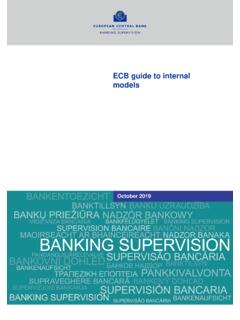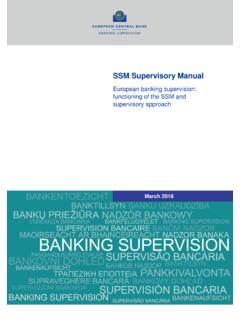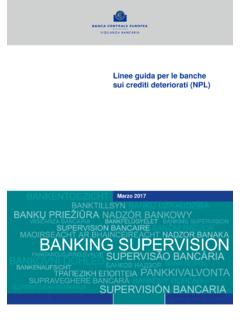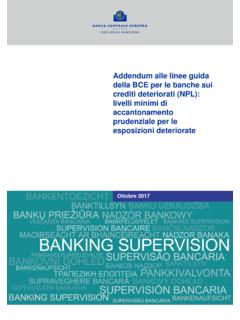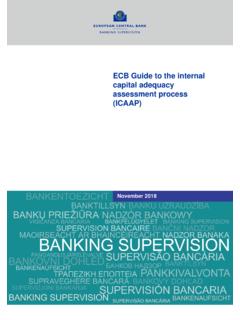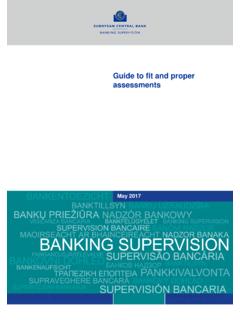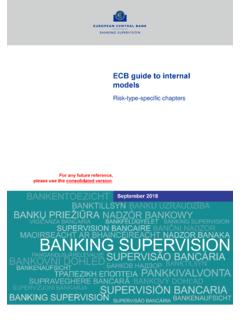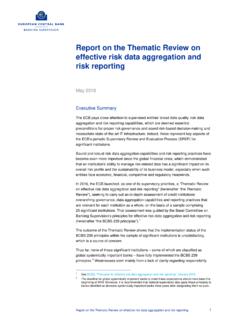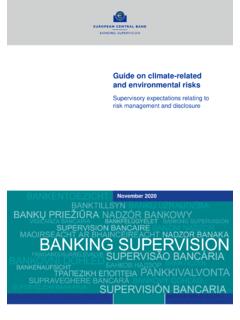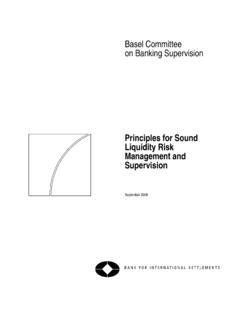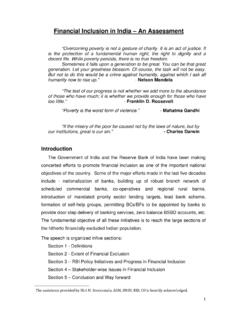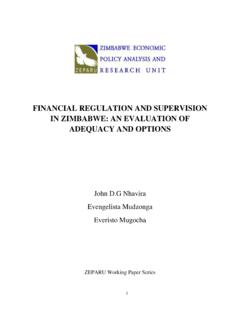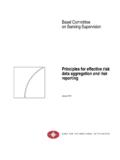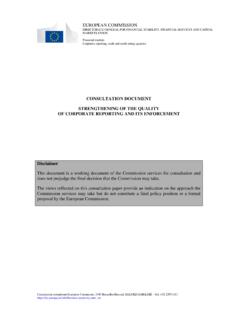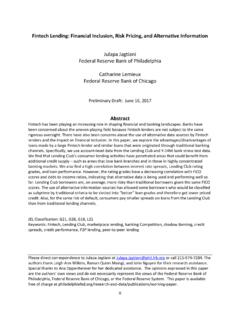Transcription of Guide for the Targeted Review of Internal Models (TRIM)
1 ECB-PUBLIC February 2017 Information on the current version (February 2017) of the Guide to the Targeted Review of Internal Models (TRIM) Dear Members of the Management Body, As announced in the invitation you have received on 6 February 2017 for the conference on the Targeted Review of Internal Models (TRIM) organised by the ECB on 28 February 2017, we are pleased to share with you the current version (February 2017) of the Guide to TRIM. This Guide sets out the ECB s view on the appropriate supervisory practices. It further spells out how the ECB intends to interpret the relevant EU law on Internal Models for credit, market and counterparty credit risks and on general model governance topics. The aim pursued by the Guide is to ensure a harmonised interpretation and application of the existing legal framework as well as also ensuring close alignment with upcoming changes in the regulation on Internal Models .
2 The Guide to TRIM will be presented to the institutions in scope for TRIM during the conference on 28 February 2017 and will be made public consecutively via the ECB Banking Superivsion website. Until this publication, this version shall not be shared with any other third party. We also invite you to provide feedback on this version of the Guide to TRIM in order to identify where further clarifications or reconsiderations of the defined principles could be helpful. To that extent, you will find attached feedback templates for each chapter, including some instructions. We kindly ask you to send back these feedback templates to by Thursday, 13 April 2017. In particular, with regard to paragraph 18 in the chapter of the Guide on counterparty credit risk, concerned institutions are invited to propose examples of quantitative impact studies to estimate model risk for cases where approximations or fall-backs are applied to transactions within (non-split) netting sets subject to the IMM, since such impacts would be the base for an increase of the alpha parameter.
3 This version of the Guide will be refined during the coming months based on the feedback received by the institutions through this process and also taking into account the outcomes of the on-site assessments performed during the TRIM on-site investigations, the results of horizontal analyses on peer groups and the latest regulatory developments. Before finalisation of the Guide , a formal public consultation will be launched for each risk type. Yours sincerely, [signed] Korbinian Ibel Director General - DG Microprudential Supervision IV Guide for the Targeted Review of Internal Models (TRIM) February 2017 For any future reference, please use the most recent version. Guide for the Targeted Review of Internal Models (TRIM) Document release Status Date of issue Release number Addressee first version 2017 02 09 SB Version to insitutions 2017 02 17 Insitutions in scope Guide for the Targeted Review of Internal Models (TRIM) Contents Foreword 1 General topics 3 1 Scope of the Guide for general topics 3 2 Overarching principles for Internal Models 4 3 Roll-out and PPU 9 4 Internal governance 11 5 Internal Audit 15 6 Internal Validation 16 7 Model use 22 8 Management of model changes 28 9 Data quality 34 10 Third party involvement 39 11 Glossary 44 Credit risk 46 1 Scope of the Guide for credit risk 46 2 Data requirements 47 3 Probability of default (PD) 50 4 Loss Given Default (LGD) 58 5 Credit conversion factor (CCF)
4 75 6 Model-related margin of conservatism 78 7 Review of estimates 81 8 Calculation of maturity for non-retail exposures 84 9 Glossary 84 Market risk 86 1 Scope of the Guide for market risk 86 2 Scope of the Internal model approach 86 Guide for the Targeted Review of Internal Models (TRIM) 3 Regulatory back-testing of VaR Models 98 4 Internal back-testing of VaR Models 104 5 Methodology for VaR and stressed VaR 108 6 Methodology for IRC Models focusing on default risk 116 7 Risks Not In the Model 123 8 Glossary 127 Counterparty credit risk 128 1 Scope of the Guide for counterparty credit risk 128 2 Trade coverage 128 3 Margin period of risk and cash flows 132 4 Collateral modelling 134 5 Modelling of initial margin 136 6 Maturity 138 7 Granularity, number of time steps and scenarios 140 8 Calibration frequency and stress calibration 142 9 Validation 143 10 Effective expected positive exposure 146 11 Alpha parameter 147 12 Glossary 149 Guide for the Targeted Review of Internal Models (TRIM) Foreword 1 Foreword The Targeted Review of Internal Models (TRIM)
5 Is aimed at enhancing the credibility and confirming the adequacy and appropriateness of approved Pillar I Internal Models permitted for use by significant institutions when calculating own funds requirements. As a major objective, TRIM focuses on the reduction of unwarranted variability in risk-weighted assets (RWA) driven by inappropriate modelling which takes advantage of the freedom granted by the current regulation. TRIM will encompass two aspects: compliance with regulatory requirements related to Internal Models , through an assessment based on the Capital Requirements Regulation1 (CRR), the Capital Requirements Directive2 (CRD IV), relevant Commission Delegated Regulations and Commission Implementing Regulations, regulatory technical standards (RTS), European Banking Authority (EBA) guidelines, and the approved European Central Bank (ECB) Banking Supervision manuals and guidelines thereby fulfilling the obligations of ECB Banking Supervision to ensure equal treatment of credit institutions and the supervisory assessment and approval of Internal Models .
6 The reduction of unwarranted variability in RWA as it relates to Internal model outcomes, taking into account the results of benchmarking, delivering interpretations of the CRR and addressing current gaps in interpretation of regulations relating to Internal Models , in situations where significant modelling issues contributing to unwarranted variability have been identified. During the preparatory phase, the ECB and the national competent authorities (NCAs), through the centres of competence (CCs) and the Harmonisation Board, have been working on the definition of topics requiring a harmonised approach to reduce unwarranted RWA variability, and, in relation to those topics, on the development of this Guide to define best-practice approaches to credit risk, market risk, counterparty credit risk and general issues related to model governance.
7 The Guide is also closely aligned with upcoming changes in the regulations on Internal Models , such as those referred to in the Fundamental Review of the Trading Book (FRTB)3 and the proposed EBA Guidelines on probability of default (PD) and loss given default (LGD)4. 1 Regulation (EU) 2013 of the European Parliament and of the Council of 26 June 2013 on prudential requirements for credit institutions and investment firms and amending Regulation (EU) No 648/2012 (OJ L 176, , ). 2 Directive 2013/36/EU of the European Parliament and of the Council of 26 June 2013 on access to the activity of credit institutions and the prudential supervision of credit institutions and investment firms (OJ L 176, , p. 338). 3 Document Minimum capital requirements for market risk issued by the Basel Committee on Banking Supervision (BCBS) in January 2016.
8 4 EBA Consultation paper on Guidelines on PD estimation LGD estimation and the treatment of defaulted exposures, 14 November 2016. Guide for the Targeted Review of Internal Models (TRIM) Foreword 2 The Guide sets out the ECB s view on the appropriate supervisory practices and how the relevant EU law should be applied in a particular area. The TRIM on-site investigations will be used to explore the range of practices for which Targeted topics requiring harmonisation should be implemented, and to identify potential shortcomings as against the best practices defined in this Guide . Horizontal analyses will start on peer groups in parallel to the missions as part of the continuous dialogue between the heads of missions and the centres of competence. This version of the Guide will be further refined during the course of the project, based on several sources of information, namely: feedback received from the institutions concerned after a conference scheduled for 28 February 2017 which will open a period for submission of written comments; the outcomes of the on-site assessments performed during the TRIM on-site investigations; horizontal analyses performed by the CCs on peer groups; the latest regulatory developments.
9 Before finalisation of the Guide , a public consultation will be launched for each risk type. At the conclusion of the TRIM project, the final Guide will be published on the ECB s Banking Supervision website. Guide for the Targeted Review of Internal Models (TRIM) General topics 3 General topics 1 Scope of the Guide for general topics 1. The purpose of this chapter of the Guide is to inform institutions of the principles for the general ( non-model specific) topics selected for harmonisation under TRIM, relating in particular to the Internal Ratings Based (IRB approach). 2. In accordance with the requirements set out in the Regulation (EU) No 575/2013 (CRR), the European Banking Authority (EBA) has prepared technical standards (Final Draft Regulatory Technical Standards on Assessment Methodology (Final Draft RTS on assessment methodology for IRB))5 that specify how competent authorities should assess compliance with the IRB framework.
10 Although at the date this document is distributed the technical standards have not yet been adopted by the European Commission, the document incorporates the principles stated in them. 3. A reference must also be made to the recent developments in the Basel IRB framework6, which will lead to a revision of that framework and the treatment of credit valuation adjustments under the CRR. Nevertheless, the principles underlying this revision were taken into consideration where relevant, in order to provide institutions with a complete overview. 4. The centre of competence for general topics gathered information about banks practices regarding credit risk in a comprehensive questionnaire launched on 1 July 2016, covering 11 general topics7. The answers and documentation collected through the survey and through on-site visits have been incorporated in th is Guide .

